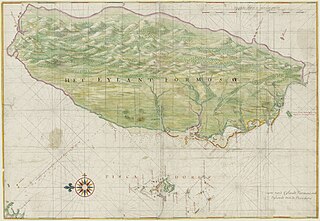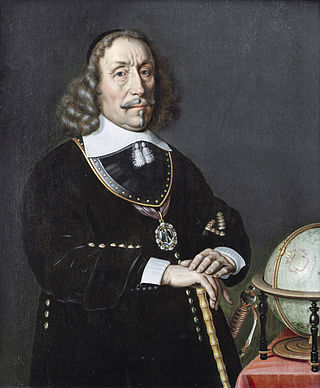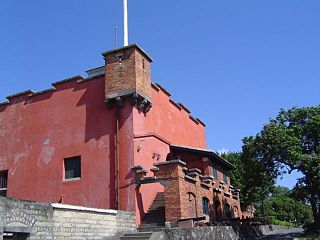
The history of the island of Taiwan dates back tens of thousands of years to the earliest known evidence of human habitation. The sudden appearance of a culture based on agriculture around 3000 BCE is believed to reflect the arrival of the ancestors of today's Taiwanese indigenous peoples. Han Chinese gradually came into contact with Taiwan starting in the late 13th century and started settling there by the early 17th century. Named Formosa by Portuguese explorers, the south of the island was colonized by the Dutch in the 17th century whilst the Spanish built a settlement in the north which lasted until 1642. These European settlements were followed by an influx of Hoklo and Hakka immigrants from Fujian and Guangdong.

Pingtung County is a county located in southern Taiwan. It has a warm tropical monsoon climate and is known for its agriculture and tourism. Kenting National Park, Taiwan's oldest national park, is located in the county. The county seat is Pingtung City.

Witte Corneliszoon de With was a Dutch naval officer who served during the Eighty Years' War and the First Anglo-Dutch War.

Fort Santo Domingo is a historical fortress in Tamsui District, New Taipei City, Taiwan. It was originally a wooden fort built in 1628 by the Spanish Empire, who named it "Fort Santo Domingo". However, the fort was then destroyed by the Spanish themselves, after losing the Second Battle of San Salvador to the Dutch Empire in 1642. After the battle, in 1644, the Dutch rebuilt a fort in the original site and renamed it "Fort Antonio". Since the Dutch were called "Red-haired People" by the Han immigrants during the time, the fort was then nicknamed "Fort Red Hair".(Chinese: 紅毛城; Pe̍h-ōe-jī: Âng-mn̂g-siâⁿ; lit. 'ang mo fort').

The island of Taiwan, also commonly known as Formosa, was partly under colonial rule by the Dutch Republic from 1624 to 1662 and from 1664 to 1668. In the context of the Age of Discovery, the Dutch East India Company established its presence on Formosa to trade with the Ming Empire in neighbouring China and Tokugawa shogunate in Japan, and also to interdict Portuguese and Spanish trade and colonial activities in East Asia.

Liuqiu, also known by several other names, is a coral island in the Taiwan Strait about 13 kilometers (8 mi) southwest of the main island of Taiwan. It has an area of 6.8 km2 (2.6 sq mi) and approximately 13,000 residents, the vast majority of whom share only 10 surnames. It is administered as a township of Pingtung County in Taiwan Province, Republic of China. As of 2019 the township chief is Chen Lung-chin.

Pieter Nuyts or Nuijts was a Dutch explorer, diplomat and politician.

Hengchun Township is a township located on the southern tip of the Hengchun Peninsula in Pingtung County, Taiwan. It is the southernmost township in Taiwan. Hengchun is also the only urban township in the southern part of Pingtung County. Hengchun has a land area of 136.76 km2 (52.80 sq mi) and has a population of 29,790 as of October 2023.

The Japanese punitive expedition to Taiwan in 1874, referred to in Japan as the Taiwan Expedition and in Taiwan and Mainland China as the Mudan incident, was a punitive expedition launched by the Japanese ostensibly in retaliation for the murder of 54 Ryukyuan sailors by Paiwan aborigines near the southwestern tip of Taiwan in December 1871. In May 1874, the Imperial Japanese Army and Imperial Japanese Navy attacked the indigenous Taiwanese peoples in southern Taiwan and retreated in December after the Qing dynasty agreed to pay an indemnity of 500,000 taels. Some ambiguous wording in the agreed terms were later argued by Japan to be confirmation of Chinese renunciation of suzerainty over the Ryukyu Islands, paving the way for de facto Japanese incorporation of the Ryukyu in 1879.

The Qing dynasty ruled over the island of Taiwan from 1683 to 1895. The Qing dynasty sent an army led by general Shi Lang and defeated the Ming loyalist Kingdom of Tungning in 1683. Taiwan was then formally annexed in April 1684.

The Gouden Leeuw was a Dutch ship of the line armed with 80-82 cannon. The ship was built for the Admiralty of Amsterdam in 1666 during the Second Anglo-Dutch War. The Gouden Leeuw was for a time the largest Dutch warship. During the Third Anglo-Dutch War, the ship served as the flagship of Lieutenant Admiral Cornelis Tromp. She was Tromp's flagship at the Battle of Texel in 1673, with the Irishman Thomas Tobiasz as his flag captain. She was broken up in 1686.
The Battle of Liaoluo Bay took place in 1633 off the coast of Fujian, China; involving the Dutch East India Company (VOC) and the Chinese Ming dynasty's navies. The battle was fought at the crescent-shaped Liaoluo Bay that forms the southern coast of the island of Kinmen. A Dutch fleet under Admiral Hans Putmans was attempting to control shipping in the Taiwan Strait, while the southern Fujian sea traffic and trade was protected by a fleet under Brigadier General Zheng Zhilong. This was the largest naval encounter between Chinese and European forces before the Opium Wars two hundred years later.

Spanish Formosa was a small colony of the Spanish Empire established in the northern tip of the island known to Europeans at the time as Formosa or to Spaniards as "Isla Hermosa" from 1626 to 1642. It was ceded to the Dutch Republic during the Eighty Years' War.
A series of military actions and diplomatic moves were undertaken in 1635 and 1636 by the Dutch East India Company (VOC) in Dutch-era Taiwan (Formosa) aimed at subduing hostile aboriginal villages in the southwestern region of the island. Prior to the campaign the Dutch had been in Formosa for eleven years, but did not control much of the island beyond their principal fortress at Tayouan, and an alliance with the town of Sinkan. The other aboriginal villages in the area conducted numerous attacks on the Dutch and their allies, with the chief belligerents being the village of Mattau, who in 1629 ambushed and slaughtered a group of sixty Dutch soldiers.

The Spanish expedition to Formosa was a campaign mounted by the Spanish based in Manila, Philippines in 1626. It was the Spanish response to Dutch settlements being built in Formosa, now known as Taiwan. In cooperation with the Portuguese, this venture was made to attract Chinese traders and curtail the expansion of Dutch power in Asia.

A Landdag was a political ceremony staged regularly by Dutch East India Company (VOC) authorities during the period of Dutch rule of Taiwan, known then as Formosa. This mass gathering of Dutch colonists and their aboriginal Formosan subjects was conceived as a device through which the Dutch, by means of a calculated display of power, prestige and paternal largesse, sought to cement their authority and the legitimacy of their rule over the native population. The Dutch word Landdag, sometimes also called rijksdag on Dutch Formosa, is roughly equivalent to the English word Diet.

Black Dwarf Cave is a cave and tourist attraction in Tianfu Village on Liuqiu Island, off Pingtung County, Taiwan. Its scenic area includes paths around the surrounding coasts and its ticket includes access to some other nearby attractions such as Mountain Pig Ditch and Beauty Cave.

Vase Rock is a rock just off Liuqiu Island of Pingtung County, Taiwan.
The earliest confirmed descriptions of visits by Han Chinese people to Taiwan occurred during the Yuan dynasty (1271–1368) and Chinese objects such as pottery were found there, suggesting trade between Taiwanese indigenous peoples and the Han Chinese in prior periods. Trade between Han and Taiwanese indigenous peoples increased during the Ming dynasty (1368–1644). Pirates and fishermen also started visiting Taiwan. By the early 17th century, there were 1,500–2,000 Han people inhabiting one or two villages in southwestern Taiwan. Most of them were engaged in seasonal fishing and left afterwards but some stayed and planted crops.

The military history of Taiwan spans at least 400 years and is the history of battles and armed actions that took place in Taiwan and its surrounding islands. The island was the base of Chinese pirates who came into conflict with the Ming dynasty during the 16th century. From 1624 to 1662, Taiwan was the base of Dutch and Spanish colonies. The era of European colonization ended when a Ming general named Koxinga retreated to Taiwan as a result of the Ming-Qing War and ousted the Dutch in 1661. The Dutch held out in northern Taiwan until 1668 when they left due to indigenous resistance. Koxinga's dynasty ruled southwestern Taiwan as the Kingdom of Tungning and attacked the Qing dynasty during the Revolt of the Three Feudatories (1673-1681).
















